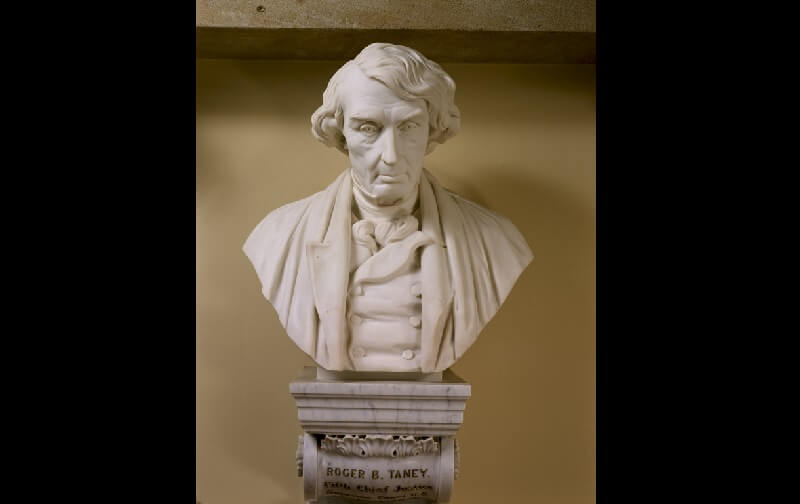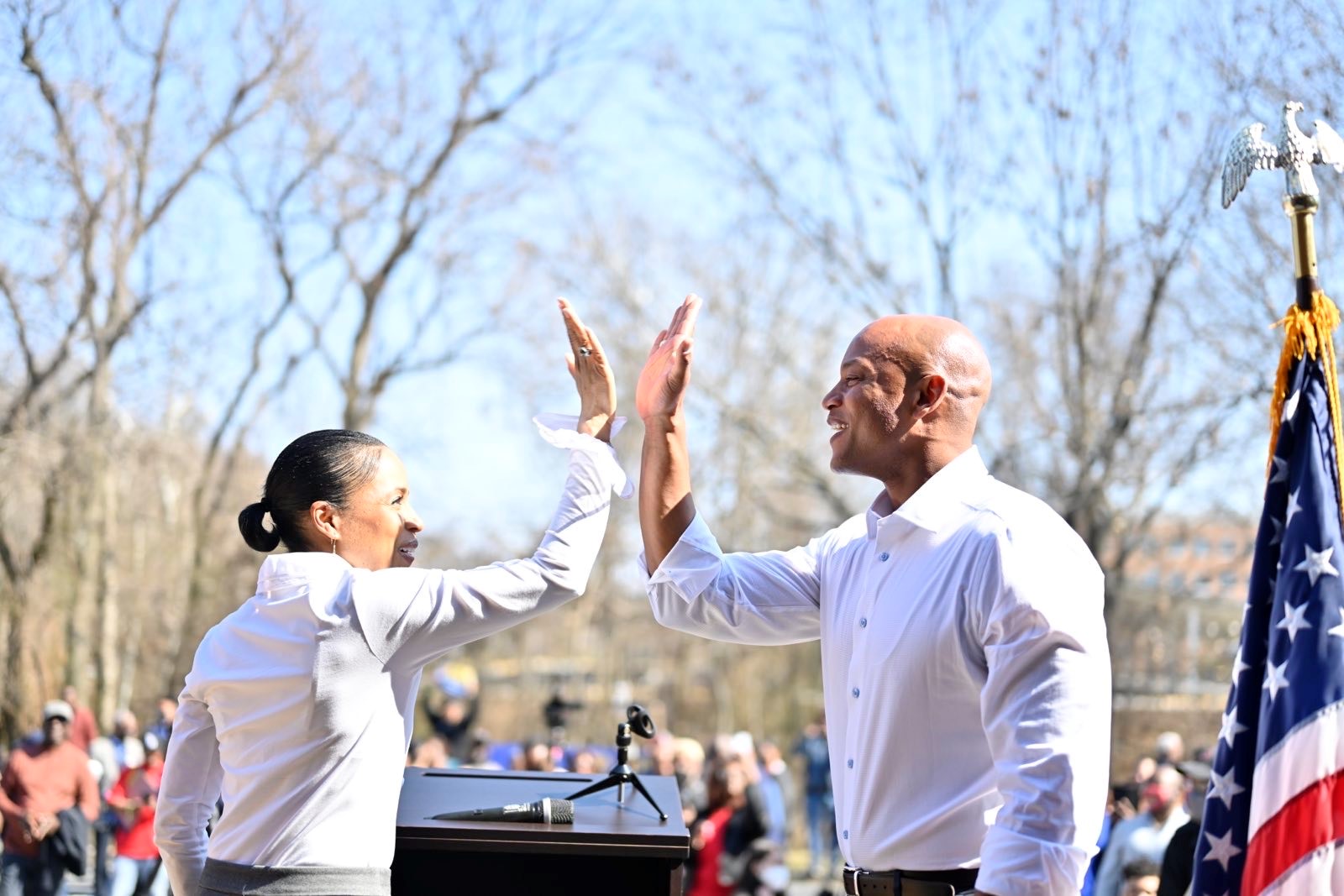Md. Delegation Wants Bust of Dred Scott Author Out of U.S. Capitol

Nearly the entire Maryland congressional delegation is pushing to remove a marble bust of one of the state’s most infamous residents – the late Supreme Court chief justice Roger B. Taney, who authored the 1857 Dred Scott decision – from the U.S. Capitol.
Both of Maryland’s U.S. senators and all but one of its U.S. House members are sponsoring legislation to get rid of the bust of Taney, which now sits outside the historic Supreme Court chambers. In its place they want a bust of Justice Thurgood Marshall, another Marylander, who became the first Black justice on the high court.
Supporters say the House could vote on legislation to make the switch by the end of the month.
Taney wrote the court’s decision in the 1857 Dred Scott case, which held that Black people could not be citizens of the United States, that Black residents were “so far inferior that they had no rights which the white man was bound to respect,” and that enslaved people were considered property under the U.S. Constitution.
The Dred Scott decision scandalized Northern residents, because it, in effect, extended the institution of slavery throughout the country. The opinion set the country down a path that inexorably led to the Civil War.
Marshall, on the other hand, led many successful legal challenges that began to dismantle racial segregation in the Jim Crow era. He was the founder and executive director of the NAACP Legal Defense and Educational Fund. His most famous victory was the landmark Brown v. Board of Education, which called for the integration of schools and marked the end of the Supreme Court’s “separate but equal” doctrine that undergirded many segregationist policies for more than half a century.
“I have long believed that it is past time to remove the bust of Roger Brooke Taney from public display in the U.S. Capitol building. Justice Taney’s opinion in the Dred Scott Supreme Court case is one of the worst decisions to ever come out of the court, and the reckoning our nation has faced in the past few weeks further illustrates the need to take this action,” said U.S. Rep. Steny H. Hoyer of Maryland, the No. 2 Democrat in the House.
“We ought to make it clear to the visitors that come to the Capitol, and the American people as a whole, that we are better than this. We should celebrate those who seek to make our society more just and inclusive, not those who sought to divide us,” he added.
Hoyer noted that Maryland’s state government removed a prominent statue of Taney on the State House grounds in Annapolis in 2017.
U.S. Rep. Andrew P. Harris, the lone Republican representing Maryland in the House, said Taney’s bust should remain. But he supported the idea of adding Marshall.
“I do not support denying history by removing Chief Justice Taney’s bust — but instead using its presence as a teaching moment by adding Justice Marshall’s bust, along with a plaque about how flawed the Dred Scott decision was ultimately found to be — the proof being the appointment of Thurgood Marshall,” Harris said in a statement.
The current debate over what to do with Taney’s likeness comes amid a national movement to reconsider memorials to prominent figures who advanced racist policies. Protesters and politicians have targeted icons such as Christopher Columbus, who slaughtered and enslaved Native Americans.
Much of the attention has focused on Civil War figures and symbols. Mississippi lawmakers recently voted to remove the Confederate battle emblem from the state’s flag, because of the standard’s long affiliation with racist policies and people. In Richmond, the capital of the Confederacy, city officials have removed six monuments honoring leaders of the insurrection. A key Senate committee has signed off on a proposal to rename military bases that are currently named after Confederates, clearing its way for adoption by the full chamber.
President Trump has lashed out against the protests, including those targeting Confederate monuments. He also threatened to veto a military spending bill if it contains the provision to rename bases named after Confederates.
A similar dynamic is playing out in the U.S. Capitol, which is full of memorials to slaveholders, segregationists and other problematic figures of the past. Democrats, including House Speaker Nancy Pelosi, have pushed to remove many of the controversial memorials. In the Senate, Majority Leader Mitch McConnell (R-Ky.) has said it should be up to states that have sent statues of divisive figures for display at the Capitol to replace those statues. But he has not weighed in on whether Taney’s bust — which was commissioned by Congress, not the state of Maryland — should be removed.
The idea of including Taney at the U.S. Capitol was controversial well before sculptor Augustus Saint-Gaudens even started carving the piece.
Taney died amid the Civil War in 1864 after leading the high court for 28 years. He had been the attorney general and treasury secretary for President Andrew Jackson before Jackson nominated Taney to become chief justice. During his time as chief justice, the high court moved to its dark courtroom at the U.S. Capitol. His bust is now displayed, along with those of several other prominent jurists, outside of that room.
Just a few months after Taney’s death, as Union armies marched through the South in February 1865, the U.S. Senate considered legislation to commission a marble bust of Taney. Congress previously did the same for previous chief justices. But U.S. Sen. Charles Sumner, an ardent anti-slavery lawmaker from Massachusetts, would have none of it.
“The name of Taney is to be hooted down the page of history,” Sumner said. “Judgment is beginning now; and an emancipated country will fasten upon him the stigma which he deserves.”
In the House, Rep. Thaddeus Stephens, another ardent anti-slavery lawmaker, said Taney’s decision in Dred Scott “damned the late chief justice to everlasting fame and, I fear, everlasting fire.”
The rebuke was only temporary, though. Seven years later, when Taney’s successor as chief justice died, Congress ordered commissions for both of the late judges. Taney’s likeness was based on the statue in Annapolis.
The Dred Scott decision did, however, catapult Abraham Lincoln into national prominence. The ruling became a major issue in the 1858 U.S. Senate race in Illinois, where Lincoln challenged U.S. Sen. Stephen Douglas in a series of debates around the state.
“Chief Justice Taney in his opinion in the Dred Scott case, admits that the language of the Declaration [of Independence] is broad enough to include the whole human family,” except for Black people, Lincoln reminded one crowd, and then added, “I think the authors of that notable instrument intended to include all men.”
Taney swore in Lincoln during his first presidential inauguration, but the two soon clashed. One of their biggest disputes was over Lincoln’s decision to suspend the writ of habeas corpus in Baltimore to protect Union troops from pro-slavery mobs. That meant that authorities would not have to describe the charges against people they arrested to detain them. Taney ruled that Lincoln could not suspend that constitutional protection without the consent of Congress.
Lincoln, an astute lawyer himself, later defended the action in an address to Congress. He said it wouldn’t be practical to enforce the rest of the laws in the city if he had to abide by the writ of habeas corpus. “Are all the laws but one to go unexecuted,” Lincoln asked, “and the government itself go to pieces lest that one be violated?”
Taney repeatedly opposed Lincoln’s use of expansive war powers, including the Emancipation Proclamation, said Ron Soodalter, president of the Abraham Lincoln Institute.
But Taney’s influence waned as Lincoln appointed more judges to the Supreme Court.
“For years, [Taney] had been the most constant judicial thorn in Lincoln’s side, refusing to give ground even as he lost his allies on the bench, his precarious health, and ultimately, his hold on the Constitution,” Soodalter explained. Lincoln replaced Taney with staunch abolitionist Salmon P. Chase.
The Democrats pushing to remove Taney’s statue at the U.S. Capitol said Marshall would be a better fit for the area outside of the historic Supreme Court courtroom.
“As our country continues to grapple with the past and future of civil rights and systemic racism, we should highlight leaders in history that have propelled us towards justice and put an end to the glorification of those who stood in its way,” U.S. Sen. Chris Van Hollen said. “Marshall’s work is a crucial reminder that we must continue pressing forward. His steadfast legacy should be memorialized in the Halls of Congress and never forgotten.”
Meanwhile, Maryland’s senior senator, Benjamin L. Cardin praised the “civil rights icon,” and noted that Marshall argued the case that desegregated the University of Maryland law school.
“Marshall is an inspiration, a person who propelled his rise from West Baltimore to the highest court in the country through hard work, intellectual evolution and unwavering morality,” Cardin said.
Daniel C. Vock is a national correspondent for States Newsroom. He can be reached at [email protected].



 Creative Commons Attribution
Creative Commons Attribution